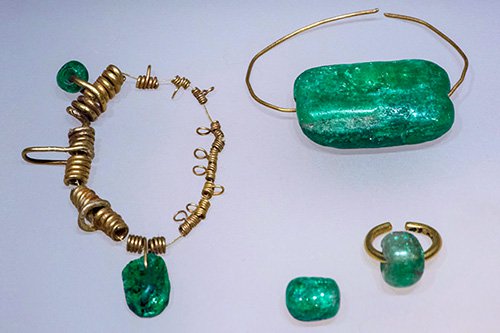The History of the Emerald
Learn more about emeralds throughout history.

Since the beginning of human thought, emerald has been considered one of the most precious and desired stones in different civilizations. The name is derived from the word Smaragdos, which in Greek means green stone or just green. In ancient times, any greenish stone was named in this way, however, the deep tone of the gem made the emerald known as the "green goddess of all stones" in Ancient Greece.
The first emeralds were discovered about 5,000 years ago, in Egypt. Subsequently, the region from which the gems were extracted, close to Cairo, received the name Minas de Cleópatra, in honor of the legendary queen known for using various emeralds as adornments in her garments. The Egyptians called the emerald the Stone of Love and believed that it could bring fertility and reincarnation. Mummies were buried with emeralds around their necks in the hope that the gems could offer eternal youth.
In this period, emeralds were exchanged and sold on the silk route and, probably, at this time, the stone was related to health and protection, since some mantras were inscribed in Sanskrit on the gems to serve as talismans.
The Greeks associated the gem with victory in wars and as a symbol of eternal love. For this reason, she has always been very attached to Aphrodite, the goddess of love. Following the same steps, the Romans used the emerald to honor Venus, the goddess equivalent to Aphrodite in the Greek pantheon.
During the Roman Empire, the stone was closely linked to the restoration of eye health. Nero, the tyrannical Roman emperor, is believed to have used lenses made of emeralds to protect his eyes while watching gladiators battle.
Although the emerald played an important role in the history of Egypt, Greece and Rome, the most beautiful specimens of the gem were housed on Latin American soil and were only discovered when the Spaniards arrived in the New World, around the 16th century.
At this time, the Incas had already used emeralds as jewelry in religious ceremonies for more than 500 years. According to legend, they had a specimen the size of an ostrich egg, which they believed to be the incarnation of the goddess Umina, who, like Aphrodite, was considered the goddess of love.
The smaller gems were considered "daughters" of Umina and could be offered as gifts to the goddess by anyone who needed extra help in the love field.
The Spaniards loved precious metals more than natural gems. This caused the Spanish colonizers to start exchanging emeralds for gold and silver with other countries.
This exchange spread the stone on the European continent and drew the attention of European and Asian royalty, which gave the stone a real symbol status.
Today, most emeralds are extracted from Colombia, Brazil and Zambia. If before they were symbols of royalty, in modern times, emeralds are very associated with celebrities and remain among the most coveted precious stones in the world.
In the golden Hollywood era, the gem won Marlene Dietrich, who loved brooches and emerald bracelets. One of his bracelets had a 97 carat copy!
Interesting facts
Here are some interesting facts and curiosities about the emerald:
In Brazil, they were discovered in 1963. The main deposits are found in Bahia, Goiás and Minas Gerais.
Napoleon Bonaparte presented Marie Louise with a wedding gift with a set of emeralds, including a tiara, a necklace, a pair of earrings and a comb.
A legend says that if in a relationship, one of the partners is unfaithful, the emerald loses its color.
The 40th wedding anniversary is represented by the emerald.
Because it has a lower density, a 1-carat emerald looks larger than a diamond of the same weight.
According to most legends, the stone should be used on the little finger, the ring finger, the heart or the right arm. Although emerald is often combined with other gem stones, it works best on its own, unless it is combined with diamonds, which intensify your energy.
Emeralds were feared by magicians, who could not act if a stone was nearby. Wherever emeralds were kept, their wearer would be protected from poisonous creatures, demonic possessions and spells.
In the 3rd century, emerald was used to treat tired eyes. It was common to find them on work desks. The custom was to pause work from time to time and look at them to alleviate eye strain.
Around the 13th century, Hindu doctors considered that emerald had a laxative effect and, in addition to curing dysentery, it reduced bile secretion and stimulated appetite.
In the first decade of the 17th century, the cure for diarrhea consisted of placing an emerald stone on the abdomen and another in the patient's mouth.
Emeralds were used as antidotes to poisons.
Carrying an emerald on the neck was one of the treatments prescribed for epilepsy.
In 2015, Brazil lost to FM Holdings, an American company, the dispute over a huge emerald found in Bahia. The stone was in dispute between Brazilian national treasury, Bahian miners, stone buyers and partners of FM Holdings over their property.
The “Duke of Devonshire” stone is one of the largest rough emeralds ever found, weighing around 1,383.93 carats. They say it belonged to the Emperor of Brazil, Dom Pedro I. Today, the emerald is on display at the London Museum of Natural History.
Source
The most important deposits are located in Colombia, including the Muzo Mine, close to Bogotá. It was exploited by the Incas and abandoned.
Later, it was rediscovered in the 17th century. In this mine are the most precious emeralds in the world. Another important deposit is the Chivor Mine, also close to Bogotá. Like Muzo, it was explored by the Incas and later by Spanish colonists.
Trapiche, a rare type of emerald, is found only in Colombian mines. This type of emerald has a natural inclusion of carbon that divides the stone into six parts, leaving it with a unique look.
In Brazil, there are several deposits in Bahia, Goiás and Minas Gerais. Generally, the stones found here are lighter than the Colombian ones, with a shade slightly more yellowish-green than bluish-green. Brazilian specimens also have fewer inclusions, a characteristic that made Brazil one of the largest exporters of emerald in the world.
In Zimbabwe, however, it is common to find smaller stones, however, of good quality. There is also an extraction site in the Urals, in Russia, however, less important, since the stones extracted from that location are opaque and cloudy. Other deposits are located in Ghana, Zambia, Tanzania, India, Pakistan, Afghanistan, Australia and the United States. Today, the famous Cleopatra Mines have only historical value.


